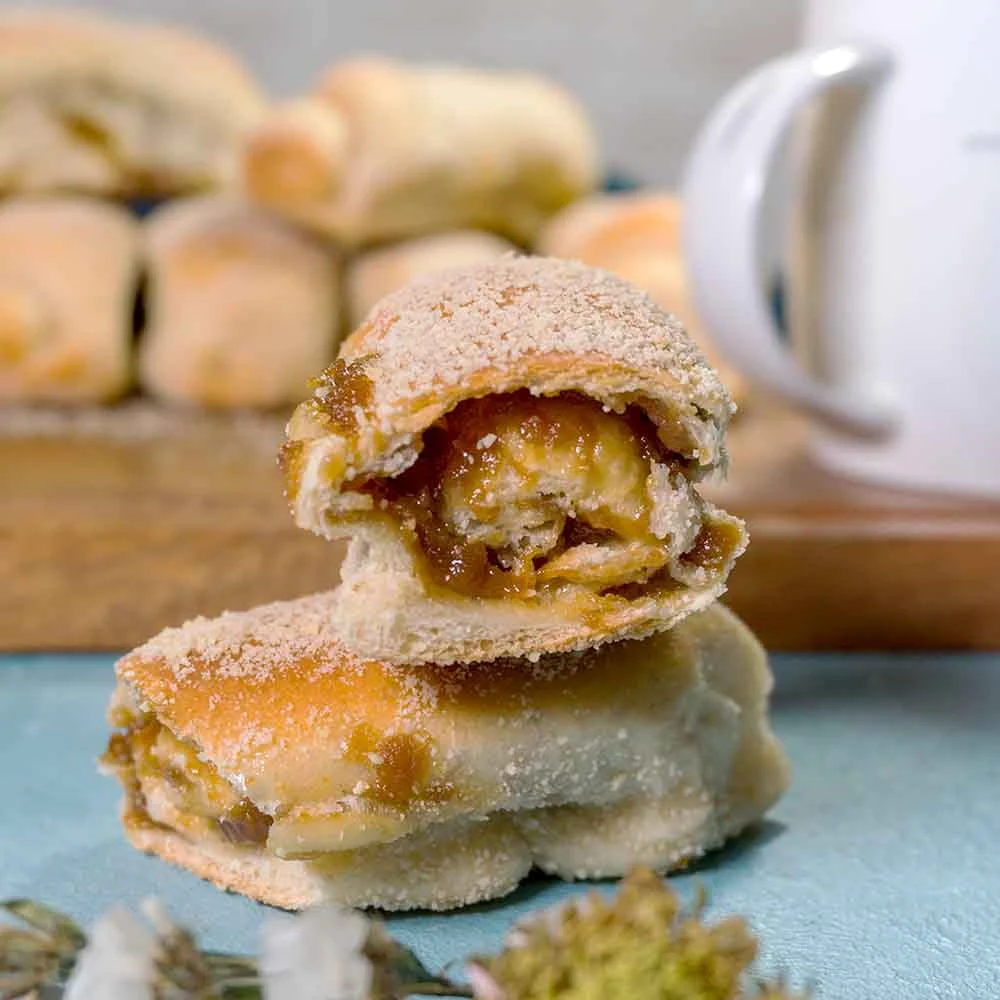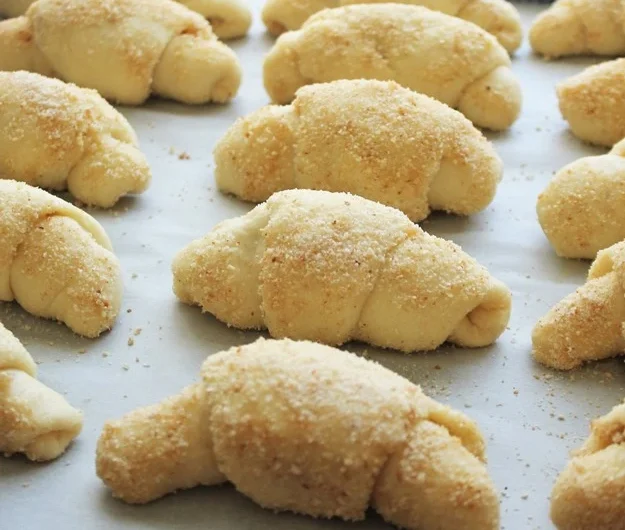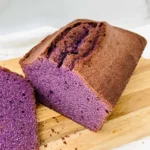Have you ever tasted a warm, freshly baked Spanish bread that was so soft and delicious, it practically melted in your mouth?
Well, get ready to embark on a culinary journey as we unveil the secrets to creating this traditional Spanish delicacy. From the delicate dough preparation to the mouthwatering filling, we will guide you through each step, ensuring that your Spanish bread turns out just as delectable as the ones you’ve savored in the past.
But, there’s a twist – a secret ingredient that will elevate your bread to a whole new level of flavor. Curious? Well, you’ll just have to keep reading to find out!
Contents
- 1 Key Takeaways
- 2 Ingredients
- 3 Dough Preparation
- 4 Filling Preparation
- 5 Shaping the Bread
- 6 Baking the Bread
- 7 Spanish Bread Recipe
- 8 Serving and Enjoying
- 9 Nutrition facts
- 10 Frequently Asked Questions
- 10.1 How Long Does It Take to Make Spanish Bread From Start to Finish?
- 10.2 Can I Use Whole Wheat Flour Instead of All-Purpose Flour for the Dough?
- 10.3 Can I Use a Different Type of Filling Instead of the Traditional Butter and Sugar Mixture?
- 10.4 Can I Freeze Spanish Bread for Later Consumption?
- 10.5 Can I Make Spanish Bread Without Using an Oven?
- 11 Conclusion
Key Takeaways
- Spanish bread is a delicious pastry that can be made with a variety of fillings and dough options to suit personal preferences and dietary restrictions.
- Properly activating the yeast and kneading the dough well are important steps in achieving a soft and fluffy texture.
- The dough should be allowed to rise until doubled in size, and then shaped into small oval shapes or other creative shapes before baking.
- After baking, Spanish bread can be served warm and enjoyed with a variety of toppings, fillings, and presentation ideas for a personalized and visually appealing treat.
Ingredients
To create a delicious batch of Spanish bread, gather all the necessary ingredients. The key ingredients for making Spanish bread include flour, sugar, yeast, milk, eggs, butter, and salt. However, there are variations and substitutions that you can consider based on your preferences and dietary restrictions.
For example, if you prefer a healthier option, you can use whole wheat flour instead of all-purpose flour. You can also substitute white sugar with honey or maple syrup for a natural sweetness.
When it comes to achieving a soft and fluffy texture in the bread, there are a few tips to keep in mind. First, make sure to activate the yeast properly by dissolving it in warm milk and allowing it to froth before adding it to the dough. This will ensure that the bread rises properly.
Additionally, kneading the dough well helps to develop the gluten, resulting in a lighter and fluffier bread. Finally, allowing the dough to rise in a warm and draft-free environment will help it to double in size and become airy.
Dough Preparation
Once you have gathered all the necessary ingredients, it’s time to dive into the process of preparing the dough for your mouthwatering Spanish bread. Follow these steps to ensure a perfect result:
- Measure and Combine: Start by measuring the flour, sugar, salt, and yeast. Combine them in a mixing bowl, making sure to evenly distribute the ingredients.
- Knead the Dough: Next, it’s time to put those kneading techniques to work. On a lightly floured surface, begin kneading the dough. Use the heel of your hand to push the dough away from you, then fold it back and repeat. Continue this process for about 10 minutes, until the dough becomes smooth and elastic.
- First Rise: Place the kneaded dough in a greased bowl and cover it with a clean kitchen towel. Let it rise in a warm, draft-free area for about 1 to 2 hours, or until it has doubled in size. This rising time allows the yeast to work its magic and develop the bread’s flavor.
- Punch Down and Shape: After the first rise, gently punch down the dough to release any air bubbles. Divide the dough into portions and shape them into small oval shapes, resembling the traditional Spanish bread.
With the dough now prepared, you’re one step closer to enjoying your delicious Spanish bread.
Filling Preparation
To prepare the filling for your mouthwatering Spanish bread, gather the following ingredients:
| Filling Options | Ingredients | Tips for a Soft Filling |
|---|---|---|
| Ube (Purple Yam) | Ube jam, butter | Mix the jam and butter well |
| Cheese | Cheese, condensed milk | Use a soft and creamy cheese |
| Custard | Custard powder, milk | Cook the custard until thick |
| Chocolate | Chocolate spread | Heat the spread for easier spreading |
Now that you have your ingredients ready, let’s dive into the different types of fillings you can use for your Spanish bread. One popular option is the Ube filling, made with Ube jam and butter. The sweetness of the jam combined with the richness of the butter creates a delightful flavor. Another delicious choice is the Cheese filling, which consists of soft and creamy cheese mixed with condensed milk. This combination provides a perfect balance of sweetness and creaminess.
If you prefer a custard filling, simply mix custard powder with milk and cook it until thick. The velvety texture of this filling will melt in your mouth, giving your Spanish bread a luscious taste. Lastly, for all the chocolate lovers out there, a chocolate spread filling is an excellent choice. Heat the spread for easier spreading and enjoy the rich and indulgent flavor it brings to your bread.
To achieve a perfectly soft filling, make sure to follow these tips. For the Ube and Cheese fillings, mix the ingredients well to ensure a smooth and consistent texture. When preparing the custard filling, make sure to cook it until thick to avoid a runny filling. And for the chocolate spread filling, heating it will make it easier to spread on the dough.
Now that you know the different types of fillings and how to achieve a soft filling, get ready to take your Spanish bread to the next level of deliciousness!
Shaping the Bread
Get creative with your hands as you shape the dough into delectable rolls for your Spanish bread. Shaping the bread is where the magic happens, turning a simple dough into beautiful, mouthwatering treats. Here are some shaping techniques, tips, and tricks to help you master the art of shaping Spanish bread:
- Roll and tuck: Take a portion of the dough and roll it into a log shape. Then, tuck the ends underneath to create a smooth and even roll. This technique ensures that the filling stays securely inside while baking.
- Twist and seal: Divide the dough into smaller portions and roll each one into a ball. Flatten the ball with your palm and add the filling in the center. Then, bring the edges together and twist to seal, creating a lovely spiral shape. This method gives your bread an elegant appearance.
- Braiding: Divide the dough into three equal portions and roll each one into a long rope. Lay the ropes side by side and start braiding them together, crossing the outer ropes over the middle one. This technique adds a beautiful visual element to your Spanish bread.
- Variations: Don’t be afraid to experiment with different shapes and sizes. From classic rolls to knots or even mini loaves, the possibilities are endless. Let your imagination run wild and create bread that reflects your unique style.
With these shaping techniques and a sprinkle of creativity, you’ll be able to transform your dough into Spanish bread that isn’t only delicious but also visually stunning. Enjoy the process and savor the freedom that comes with shaping your own bread.
Baking the Bread
Now that you have shaped the dough into delectable rolls, it’s time to move on to the next exciting step: baking the Spanish bread. Baking is where the magic happens, transforming your dough into golden, delicious rolls that will tantalize your taste buds. The baking time and temperature control are crucial to achieving the perfect texture and flavor.
Preheat your oven to 350°F (175°C), ensuring that it’s fully heated before placing the rolls inside. This will help the bread rise evenly and develop a beautiful golden crust. The baking time will vary depending on the size of your rolls, but a good rule of thumb is to bake them for around 15 to 20 minutes. Keep a close eye on them to prevent overbaking, as this can result in dry bread.
During the baking process, the temperature control is essential. If your oven runs hot, you may need to adjust the temperature slightly lower to avoid burning the bread. Similarly, if your oven runs cool, you may need to increase the temperature slightly to ensure the bread bakes through evenly.
Once the baking time is up, carefully remove the rolls from the oven and let them cool on a wire rack. The aroma of freshly baked Spanish bread will fill your kitchen, tempting you to take a bite right away. Exercise patience and allow the bread to cool completely before indulging in its warm, soft goodness.
Spanish Bread Recipe
Course: BreakfastCuisine: Spanish-inspiredDifficulty: Moderate4
servings30
minutes40
minutes300
kcalSpanish Bread, also known as Pan de Sal, is a delightful and popular breakfast bread in the Philippines with a Spanish influence. These soft and slightly sweet bread rolls are often enjoyed with coffee or as a snack. The unique twist comes from the sweet breadcrumb filling, providing a satisfying crunch and additional flavor. This recipe yields a batch of delicious Spanish bread that's perfect for sharing with family and friends.
Ingredients
4 cups all-purpose flour
1/2 cup sugar
1 teaspoon salt
1 tablespoon active dry yeast
1 cup warm milk
1/4 cup unsalted butter, melted
1 large egg
1/2 cup sugar
1/4 cup butter, softened
Directions
- In a small bowl, dissolve the yeast in warm milk and let it sit for about 5 minutes until it becomes frothy.
- In a large mixing bowl, combine the flour, sugar, and salt. Make a well in the center and add the yeast mixture, melted butter, and egg.
- Mix the ingredients until a dough forms. Knead the dough on a floured surface for about 8-10 minutes until it becomes smooth and elastic.
- Place the dough in a greased bowl, cover it with a damp cloth, and let it rise in a warm place for about 1-2 hours or until it doubles in size.
- While waiting for the dough to rise, prepare the filling by combining breadcrumbs, sugar, and softened butter in a bowl. Mix until well combined.
- Once the dough has doubled in size, punch it down and divide it into smaller portions. Take a portion, flatten it, and add a portion of the filling in the center. Seal the edges and shape it into a log.
- Bake in the preheated oven for about 15-20 minutes or until the bread turns golden brown.
- Allow the Spanish bread to cool before serving.
Serving and Enjoying
Indulge in the delightful experience of savoring the warm, soft goodness of freshly baked Spanish bread. As you take your first bite, the crusty exterior gives way to a tender and fluffy interior, releasing a burst of aromatic flavors.
Now that your Spanish bread is ready, it’s time to serve and enjoy this delectable treat. Here are some serving suggestions, variations, and toppings to elevate your experience:
- Serve the Spanish bread warm, straight from the oven, to fully enjoy its irresistible texture and aroma.
- For a traditional touch, spread a generous amount of creamy butter on a freshly sliced piece of Spanish bread. Let it melt and meld with the bread, creating a perfect harmony of flavors.
- If you crave a touch of sweetness, drizzle some honey over the bread. The combination of the slightly sweetened dough and the golden honey creates a heavenly balance.
- For a more indulgent experience, try adding a dollop of Nutella on top of your Spanish bread. The creamy hazelnut spread adds a rich and decadent element to every bite.
Now that you have these serving suggestions, feel free to explore your own variations and experiment with different toppings. Whether you choose to keep it simple or get creative, savor every moment as you enjoy the delightful Spanish bread you have created.
Nutrition facts
- Calories: Approximately 260-280 kcal
- Total Fat: 9-11g
- Saturated Fat: 5-6g
- Trans Fat: 0g
- Cholesterol: 35-45mg
- Sodium: 240-260mg
- Total Carbohydrates: 38-40g
- Dietary Fiber: 1-2g
- Sugars: 12-15g
- Protein: 5-6g
Frequently Asked Questions
How Long Does It Take to Make Spanish Bread From Start to Finish?
Making Spanish bread from start to finish typically takes about 2 to 3 hours. However, with some Spanish bread variations and a few tips for speeding up the process, you can enjoy this delicious treat even faster.
Can I Use Whole Wheat Flour Instead of All-Purpose Flour for the Dough?
Yes, you can use whole wheat flour instead of all-purpose flour for the dough in the Spanish bread recipe. It will give your bread a nuttier flavor and a denser texture.
Can I Use a Different Type of Filling Instead of the Traditional Butter and Sugar Mixture?
Yes, you can definitely use a different type of filling for Spanish bread. Get creative and try experimenting with healthier options like fruit preserves, cream cheese, or even a chocolate hazelnut spread.
Can I Freeze Spanish Bread for Later Consumption?
Yes, you can freeze Spanish bread for later consumption. It’s a convenient way to have it on hand whenever you crave it. As for alternative fillings, get creative and experiment with different flavors. Enjoy!
Can I Make Spanish Bread Without Using an Oven?
You can definitely make Spanish bread without using an oven! There are alternative cooking methods available, such as using a stovetop or even a microwave. Here’s a no-bake Spanish bread recipe to try. Enjoy the freedom of experimenting in the kitchen!
Conclusion
In the delightful journey of creating Spanish bread, we’ve blended the warmth of dough with the sweetness of filling, resulting in a tantalizing treat that will transport your taste buds to the sun-kissed streets of Spain.
As the bread emerges from the oven, its golden crust crackling with anticipation, you can’t help but be captivated by the aroma that fills the room.
With each bite, you embark on a flavor adventure that enchants and satisfies, leaving you yearning for more.
Buen provecho!






